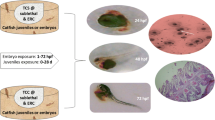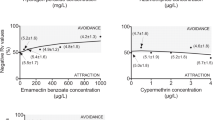Abstract
Triclosan (TCS) and triclocarban (TCC) are two common antimicrobial agents found in many personal care products and subsequently are detected ubiquitously in wastewater effluent and receiving waters. Both compounds are of recent regulatory interest due to their omnipresence in the environment, including in humans. Although TCS and TCC have been suggested to be endocrine active, little information exists about their effects on organismal end points in development (growth, escape performance), anatomy (morphological indices, histology), physiology (vitellogenin), and behavior of exposed aquatic organisms. In this study, newly hatched fathead minnows were exposed for 12 days, and mature male and female fathead minnows (Pimephales promelas) were exposed for 21 days to environmentally realistic concentrations (nanograms per liter) of these two compounds singularly and in mixtures. At the end of the exposure, larvae were assessed for growth and predator-avoidance performance, and a subset of mature fish was assessed for plasma vitellogenin induction, expression of secondary sexual characteristics, relative size of liver and gonads, and histopathological changes to both organs. The remaining exposed mature fish were placed in breeding pairs of one male and one female minnow from the same treatment to assess their ability to defend a nest site and reproduce. Exposure to either antimicrobial compound, alone or as a mixture, caused no changes to larval fish, gonad size, or vitellogenin concentrations in mature fathead minnows. In contrast, decreased aggression was seen in adult male fathead minnows exposed to TCC (1.6 μg/l) or a mixture (560 ng/l TCS + 179 ng/l TCC and 1.6 μg/l TCS + 450 ng/l TCC). Decreased aggression would likely decrease their ability to defend and hold a nest site needed for spawning and reproduction. Substantial variability was found in the severity of observed effects within treatments, suggesting that environmentally realistic concentrations of these compounds may only affect particularly sensitive individuals.



Similar content being viewed by others

References
Adolfsson-Erici M, Pettersson M, Parkkonen J, Sturve J (2002) Triclosan, a commonly used bactericide found in human milk and in the aquatic environment in Sweden. Chemosphere 46:1485–1489
Ahn KC, Zhao B, Chen J, Cherednichenko G, Sanmarti E, Denison MS et al (2008) In vitro biologic activities of the antimicrobials triclocarban, its analogs, and triclosan in bioassay screens: Receptor-based bioassay screens. Environ Health Perspect 116:1203–1210
Ankley G, Jensen KM, Kahl MD, Durhan EJ, Makynen EA, Cavallin JE et al (2010) Use of chemical mixtures to differentiate mechanisms of endocrine action in a small fish model. Aquat Toxicol 99:389–396
Barber LB, Lee KE, Swackhamer D, Schoenfuss HL (2007) Response of male fathead minnows exposed to wastewater treatment plant effluent, effluent treated with XAD8 resin, and an environmentally relevant mixture of alkylphenol compounds. Aquat Toxicol 82:26–46
Bester K (2005) Fate of triclosan and triclosan-methyl in sewage treatment plants and surface waters. Arch Environ Contam Toxicol 49:9–17
Carson FL (1997) Histotechnology. ASCP Press, Chicago
Chalew TEA, Halden RU (2009) Environmental exposure of aquatic and terrestrial biota to triclosan and triclocarban. J Am Water Resour Assoc 45:4–13
Chen J, Ahn KC, Gee NA, Ahmed MI, Dubela AJ, Zhao L et al (2008) Triclocarban enhances testosterone action: a new type of endocrine disruptor? Endocrinology 149:1173–1179
Chu S, Metcalfe CD (2007) Simultaneous determination of triclocarban and triclosan in municipal biosolids by liquid chromatography tandem mass spectrometry. J Chromatogr A 1164:212–218
Ciba-Geigy Limited (1991) Report on the bioaccumulation of FAT-80’023/Q. Unpublished test report no. G 069 09. Ciba-Geigy Limited, Basel, Switzerland
Coogan MA, La Point TW (2008) Snail bioaccumulation of triclocarban, triclosan, and methyltriclosan in a Borth, Texas, USA, stream affected by wastewater treatment plant runoff. Environ Toxicol Chem 27:1788–1793
Coogan MA, Edziyie RE, La Point TW, Venables BJ (2007) Algal bioaccumulation of triclocarban, triclosan, methyl-triclosan in a North Texas wastewater treatment plant receiving stream. Chemosphere 67:1911–1918
Dammann AA, Shappell NW, Bartell SE, Schoenfuss HL (2011) Comparing biological effects and potencies of estrone and 17β-estradiol in mature fathead minnows, Pimephales promelas. Aquat Toxicol 105:559–568
Daughton CG, Ternes TA (1999) Pharmaceuticals and personal care products in the environment: agents of subtle change? Environ Health Perspect 107:907–938
Denny JS (1987) Guidelines for the culture of fathead minnows Pimephales promelas for the use in toxicity tests. EPA/600/3-87/001
Fair PA, Lee HB, Adams J, Darling C, Pacepavicius G, Alaee M et al (2009) Occurrence of triclosan in plasma of wild Atlantic bottlenose dolphins (Tursiops truncatus) and in their environment. Environ Pollut 157:2248–2254
Foran CM, Bennett ER, Benson WH (2000) Developmental evaluation of a potential non-steroidal estrogen: Triclosan. Mar Environ Res 50:153–156
Fulton TW (1904) The rate of growth of fishes. Fisheries Board of Scotland, Annual Report 22 part 3, pp 141–241
Gabe M (1976) Histological techniques. Springer-Verlag, New York
Gatidou G, Vassalou E, Thomaidis NS (2010) Bioconcentration of selected endocrine disrupting compounds in the Mediterranean mussel, Mytilus galloprovincialis. Mar Pollut Bull 60:2111–2116
Gee RH, Charles A, Taylor N, Darbre PD (2008) Oestrogenic and androgenic activity of triclosan in breast cancer cells. J Appl Toxicol 28:78–91
Glassmeyer ST, Furlong ET, Kolpin DW, Cahill JD, Zaugg SD, Werner SL et al (2005) Transport of chemical and microbial compounds from known wastewater discharges: potential for use as indicators of human fecal contamination. Environ Sci Technol 39:5157–5169
Halden RU, Paull DH (2005) Co-occurrence of triclocarban and triclosan in U.S. water resources. Environ Sci Technol 39:1420–1426
Hinther A, Bromba CM, Wulff JE, Helbing CC (2011) Effects of triclocarban, triclosan, and methyl triclosan on thyroid hormone action and stress in frog and mammalian culture systems. Environ Sci Technol 45:5395–5402
Hyndman KM, Biales A, Bartell SE, Schoenfuss HL (2010) Assessing the effects of exposure timing on biomarker expression using 17ß-estradiol. Aquat Toxicol 96:264–272
Ishibashi H, Matsumura N, Hirano M, Matsuoka M, Shiratsuchi H, Ishibashi Y et al (2004) Effects of triclosan on the early life stages and reproduction of medaka Oryzias latipes and induction of hepatic vitellogenin. Aquat Toxicol 67:167–179
Klein DR, Flannelly DF, Schultz MM (2010) Quantitative determination of triclocarban in wastewater effluent by stir bar sorptive extraction and liquid desorption-liquid chromatography-tandem mass spectrometry. J Chromatogr A 1217:1742–1747
Kolpin DW, Furlong ET, Meyer MT, Thurman EM, Zaugg SD, Barber LB et al (2002) Pharmaceuticals, hormones, and other organic wastewater contaminants in U.S. streams 1999–2000: a national reconnaissance. Environ Sci Technol 36:1202–1211
Matsumura N, Ishibashi H, Hirano M, Nagao Y, Watanabe N, Shiratsuchi H et al (2005) Effects of nonylphenol and triclosan on production of plasma vitellogenin and testosterone in male South African clawed frogs (Xenopus laevis). Biol Pharmacol Bull 28:1748–1751
McGee MR, Julius ML, Vajda AM, Norris DO, Barber LB, Schoenfuss HL (2009) Predator avoidance performance of larval fathead minnows (Pimephales promelas) following short-term exposure to estrogen mixtures. Aquat Toxicol 91:355–361
Miller MC, Mohrenweiser HW, Bell DA (2001) Genetic variability in susceptibility and response to toxicans. Toxicol Lett 120:269–280
Morall D, McAvoy D, Schatowitz B, Inauen J, Jacob M, Hauk A et al (2004) A field study of triclosan loss rates in river water (Cibolo Creek, TX). Chemosphere 54:653–660
Mottaleb MA, Usenko S, O’Donnell JG, Ramirez AJ, Brooks BW, Chambliss CK (2009) Gas chromatography-mass spectrometry screening methods for select UV filters, synthetic musks, alkylphenols, and antimicrobial agent, and an insect repellant in fish. J Chromatogr A 1216:815–823
Oleksiak MF, Churchill GA, Crawford DL (2002) Variation in gene expression within and among natural populations. Nature 32:261–266
Orvos DV, Versteeg DJ, Inauen J, Capdevielle M, Rothenstein A, Cunningham V (2002) Aquatic toxicity of triclosan. Environ Toxicol Chem 21:1338–1349
Painter MR, Buerkley MA, Julius ML, Vajda AM, Norris DO, Barber LB et al (2009) Antidepressants at environmentally relevant concentrations affect predator avoidance behavior of larval fathead minnows (Pimephales promelas). Environ Toxicol Chem 28:2677–2684
Parks LG, Cheek AO, Denslow ND, Heppell SA, McLachlan JA, LeBlanc GA et al (1999) Fathead minnow (Pimephales promelas) vitellogenin: purification, characterization and quantitative immunoassay for the detection of estrogenic compounds. Comp Biochem Physiol C 123:113–125
Raut SA, Angus RA (2010) Triclosan has endocrine-disrupting effects in male western mosquitofish, Gambusia affinis. Environ Toxicol Chem 29:1287–1291
Richardson SD (2010) Environmental mass spectrometry: emerging contaminants and current issues. Anal Chem 82:4742–4774
Sapkota A, Heidler J, Halden RU (2007) Detection of triclocarban and two co-contaminating chlorocarbanilides in U.S. aquatic environments using isotope dilution liquid chromatography tandem mass spectrometry. Environ Res 103:21–29
Sargent RC (1989) Allopaternal care in the fathead minnow, Pimephales promelas: stepfathers discriminate against their adopted eggs. Behav Ecol Sociobiol 25:379–385
Schoenfuss HL, Bartell SE, Bistodeau TB, Cediel RA, Grove KJ, Zintek L et al (2008) Impairment of the reproductive potential of male fathead minnows by environmentally relevant exposures to 4-nonyphenol. Aquat Toxicol 86:91–98
Shappell NW, Hyndman KM, Bartell SE, Schoenfuss HL (2010) Comparative biological effects and potency of 17a- and 17b estradiol in fathead minnows. Aquat Toxicol 100:1–8
Smith RJF (1978) Seasonal changes in the histology of the gonads and dorsal skin of the fathead minnow, Pimephales promelas. Can J Zool 56:2103–2109
Smith JS, Thomas P (1990) Binding characteristics of the hepatic estrogen receptor of the spotted seatrout, Cynoscion nebulosus. Gen Comp Endocrinol 77:29–42
Taves MD, Desjardins JK, Mishra S, Balshine S (2009) Androgens and dominance: sex-specific patterns in a highly social fish (Neolamprologus pulcher). Gen Comp Endocrinol 161:202–207
Theodorakis CW (2003) Establishing causality between population genetic alterations and environmental contamination in aquatic organisms. Hum Ecol Risk Assess 9:37–58
Unger LM (1983) Nest defense by deceit in the fathead minnow, Pimephales promelas. Behav Ecol Sociobiol 13:125–130
Vajda AM, Barber LB, Gray JL, Lopez EM, Woodling JD, Norris D (2008) Reproductive disruption in fish downstream from an estrogenic wastewater effluent. Environ Sci Technol 42:3407–3414
Valters K, Li XH, Alaee M, D’Sa I, Marsh G, Bergman A et al (2005) Polybrominated diphenyl ethers and hydroxylated and methoxylated brominated and chlorinated analogues in the plasma of fish from the Detroit River. Environ Sci Technol 39:5612–5619
Veldhoen N, Skirrow RC, Osachoff H, Wigmore H, Clapson DJ, Gunderson MP et al (2006) The bactericidal agent triclosan modulates thyroid hormone-associated gene expression and disrupts postembryonic anuran development. Aquat Toxicol 80:217–227
Wilkinson GR (2005) Drug metabolism and variability among patients in drug response. New Engl J Med 352:2211–2221
Xia K, Lakhwinder SH, Kumar K, Armbrust K, Cox AE, Granato TC (2010) Triclocarban, triclosan, polybrominated diphenyl ethers, and 4-nonylphenol in biosolids and in soil receiving 33-year biosolids application. Environ Toxicol Chem 29:597–605
Yokoto H, Seki M, Maeda M, Oshima Y, Tadokora H, Honjo T et al (2001) Life-cycle toxicity of 4-nonyphenol to medaka (Oryzias latipes). Environ Toxicol Chem 20:2552–2560
Yu MS, Ho S-H (1989) Seasonal variation in hepatic binding of estrogen in the turtle, Chrysemys picta. Gen Comp Endocrinol 75:472–480
Acknowledgments
This research was supported in part by a grant from the National Science Foundation (CHE-0821110). Additional support was provided through the Henry Luce III Fund for Distinguished Scholarship and the Sophomore Research program, which are both awarded through the College of Wooster. The authors also want to thank Madigan Murphy for laboratory assistance.
Author information
Authors and Affiliations
Corresponding author
Electronic Supplementary Material
Below is the link to the electronic supplementary material.
Rights and permissions
About this article
Cite this article
Schultz, M.M., Bartell, S.E. & Schoenfuss, H.L. Effects of Triclosan and Triclocarban, Two Ubiquitous Environmental Contaminants, on Anatomy, Physiology, and Behavior of the Fathead Minnow (Pimephales promelas). Arch Environ Contam Toxicol 63, 114–124 (2012). https://doi.org/10.1007/s00244-011-9748-x
Received:
Accepted:
Published:
Issue Date:
DOI: https://doi.org/10.1007/s00244-011-9748-x



